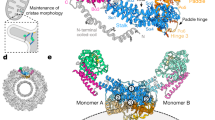Summary
Paired twisted filaments (PTF) forming helices are described in tumor cells of three human pine-alomas. Each filament was 8.11±1.55 nm wide. The maximal width of the helix was 16.62±2.62 nm. The periodicity of the constrictions was 26.63±4.49 nm. These characteristics appeared original, suggesting protein, filaments possibly specific of pinealocytes. The similarities and discrepancies between PTF and Alzheimer's paired helical filaments (PHF) are discussed.
Similar content being viewed by others
References
Hassoun J, Gambarelli D, Peragut JC, Toga M (1983) Specific ultrastructural markers of human pinealomas. A study of four cases. Acta Neuropathol (Berl) 62:31–40
Herrick MK, Rubinstein LJ (1979) The cytological differentiating potential of pineal parenchymal neoplasms (true pinealomas). Brain 102:289–320
Kidd M (1963) Paired, helical filaments in electron microscopy of Alzheimer's disease. Nature 197:192–193
Kline KT, Damjanov I, Moriber-katz S, Schmidek H (1979) Pinealoblastoma: an electron microscopic study. Cancer 44:1692–1699
Markesberry WR, Haugh RM, Young AB (1981) Ultrastructure of pineal parenchyma neoplasms. Acta Neuropathol (Berl) 55:143–149
Møller M (1974) The ultrastructure of the human fetal pineal gland. I. Cell types and blood vessels. Cell Tissue Res 152:13–30
Nielsen SL, Wilson WB (1975) Ultrastructure of a “pineocytoma”. J Neuropathol, Exp Neurol 34:148–158
Peters A, Palay SL, De F, Webster H (1976) The fine structure of the nervous system. Saunders, Philadelphia
Pevet P (1979) Secretory processes in the mammalian pinealocytes under natural and experimental conditions. Prog Brain Res 52:149–194
Vollrath L (1981) The pineal organ. Springer, Berlin Heidelberg New York
Wang GP, Grundke-Iqbal I, Kascsak RJ, Iqbal, K, Wisniewski HM (1984) Alzheimer neurofibrillary tangles: monoclonal antibodies to inherent antigen(s). Acta Neuropathol (Berl) 62:259–267
Welsh MG, Reiter RJ (1978) The pineal gland of the gerbil Merions unguiculatus. I., An ultrastructural study. Cell Tissue Res 193:323–336
Wisniewski HM, Narang HK, Terry RD (1976) Neurofibrillary tangles of paired helical filaments. J Neurol Sci 27:173–181
Wisniewski K, Jervis GA, Moretz RC, Wisniewski HM (1979) Alzheimer neurofibrillary tangles in diseases other than senile and presenile dementia. Ann Neurol 5:288–294
Wisniewski HM, Merz GS, Merz PA, Wen GY, Iqbal K (1983) Morphology and biochemistry of neuronal paired helical filaments and amyloid fibers in humans and animals. In: Zimmerman HM (ed) Progress in neuropathology, vol 5. Raven Press, New York, pp 139–150
Author information
Authors and Affiliations
Additional information
Supported by a grant from FEGEFLUC (Fédération Nationale des Groupements des Entreprises Françaises dans la Lutte contre le Cancer), Marseille, France
Rights and permissions
About this article
Cite this article
Hassoun, J., Devictor, B., Gambarelli, D. et al. Paired twisted filaments a new ultrastructural marker of human pinealomas?. Acta Neuropathol 65, 163–165 (1984). https://doi.org/10.1007/BF00690471
Received:
Accepted:
Issue Date:
DOI: https://doi.org/10.1007/BF00690471




